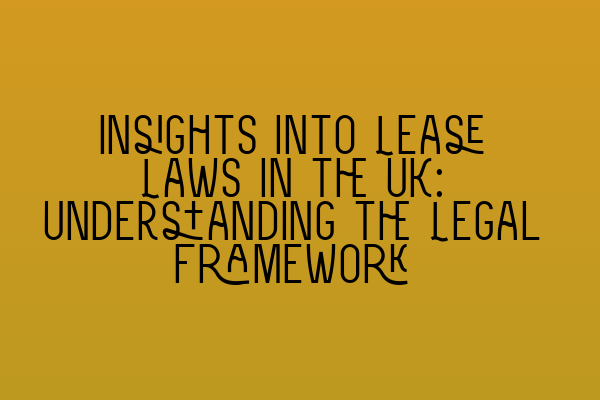Insights into Lease Laws in the UK: Understanding the Legal Framework
Lease laws in the UK can be complex and confusing, especially for individuals who are not familiar with the legal framework surrounding property contracts. Whether you are a landlord or a tenant, it is crucial to have a solid understanding of lease laws to protect your rights and obligations.
What is a Lease?
A lease is a legal document that outlines the terms and conditions of a rental agreement between a landlord (the property owner) and a tenant (the person occupying the property). It establishes the rights and responsibilities of both parties, ensuring a fair and harmonious relationship.
Leases can be short-term or long-term, depending on the duration agreed upon by the landlord and tenant. Short-term leases are typically for a period of less than six months, while long-term leases can extend for several years. It is essential to clearly define the duration of the lease in the agreement to avoid any misunderstandings or disputes in the future.
Key Components of a Lease Agreement
A well-drafted lease agreement should include the following key components:
- Rental Amount and Payment Terms: The lease should clearly state the monthly rental amount and outline the payment terms, including due date, late fees, and acceptable methods of payment.
- Security Deposit: It is common for landlords to require tenants to pay a security deposit, which serves as protection against any damages or unpaid rent. The terms of the security deposit, such as the amount and conditions for its return, should be clearly specified in the lease.
- Repairs and Maintenance: The lease should outline the responsibilities of both the landlord and the tenant regarding repairs and maintenance of the property. This includes specifying who is responsible for minor repairs, as well as outlining the procedures for reporting and addressing any maintenance issues.
- Use and Restrictions: The lease should clearly state the permitted use of the property and any restrictions or prohibitions, such as subletting, running a business, or having pets.
- Termination and Renewal: The lease should include provisions for termination and renewal, including notice periods required by both parties. This ensures that both the landlord and the tenant have clarity on how and when the lease can be ended or extended.
Legal Rights and Protections
Both landlords and tenants have legal rights and protections under lease laws in the UK. Understanding these rights is essential for a fair and balanced landlord-tenant relationship.
For landlords, these rights may include:
- Right to receive rent payment on time
- Right to enter the property for inspections or repairs, with proper notice
- Right to take legal action for unpaid rent or damages to the property
For tenants, these rights may include:
- Right to quiet enjoyment of the property
- Right to request repairs and maintenance
- Right to challenge rent increases
It is important for both parties to familiarize themselves with these rights to avoid any potential legal conflicts.
When disputes arise between landlords and tenants, it is advisable to seek legal advice to ensure a fair resolution. SQE Property Law & Land Law can provide expert guidance and representation in lease-related matters.
Conclusion
Lease laws in the UK play a vital role in establishing a fair and balanced relationship between landlords and tenants. Understanding the legal framework surrounding lease agreements is crucial for both parties to protect their rights and obligations. By ensuring the lease agreement covers all essential components and being aware of their legal rights, landlords and tenants can create a harmonious living or business environment.
For more information on related legal topics, you may be interested in these articles:
